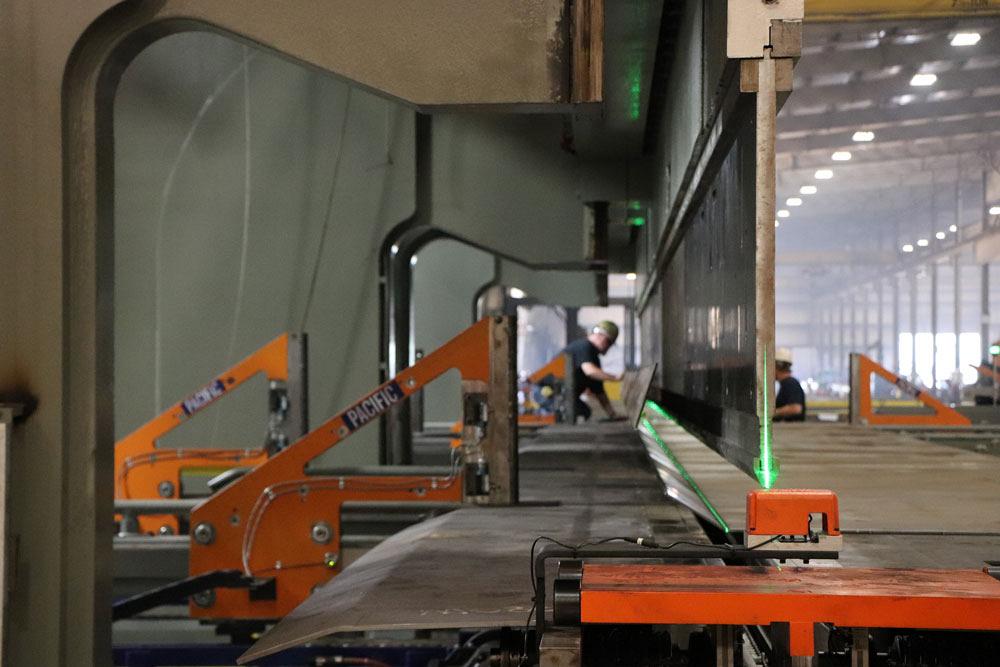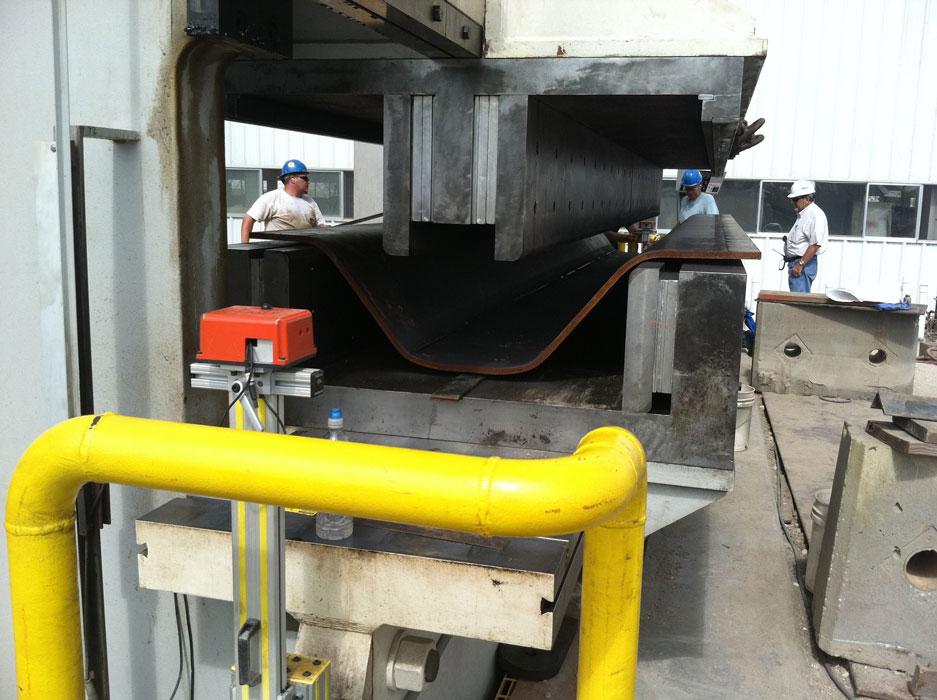Sales Manager
- FMA
- The Fabricator
- FABTECH
- Canadian Metalworking
Categories
- Additive Manufacturing
- Aluminum Welding
- Arc Welding
- Assembly and Joining
- Automation and Robotics
- Bending and Forming
- Consumables
- Cutting and Weld Prep
- Electric Vehicles
- En Español
- Finishing
- Hydroforming
- Laser Cutting
- Laser Welding
- Machining
- Manufacturing Software
- Materials Handling
- Metals/Materials
- Oxyfuel Cutting
- Plasma Cutting
- Power Tools
- Punching and Other Holemaking
- Roll Forming
- Safety
- Sawing
- Shearing
- Shop Management
- Testing and Measuring
- Tube and Pipe Fabrication
- Tube and Pipe Production
- Waterjet Cutting
Industry Directory
Webcasts
Podcasts
FAB 40
Advertise
Subscribe
Account Login
Search
Should you invest in a custom press brake?
The risks and rewards of investing in a custom press brake
- By Chris Robinson
- February 28, 2018
- Article
- Bending and Forming

This custom press brake has a deep throat to accommodate handling requirements for large, tall, and long parts, such as utility poles. The backgauges and safeguarding are designed so operators can safely access the work from behind the tooling.
For a fabrication shop bending 8-foot sheets of 0.25-inch-thick A36 steel into channels or troughs, an 8- to 10-ft. press brake with typical punch and die combinations will get the job done. Some specialty applications, however, need a press brake custom-built to meet the forming challenges at hand.
What Defines a Custom Press Brake?
To answer this, we first need to define what a “standard” press brake really is. This isn’t as straightforward as it sounds, considering the range of press brakes and machine options available.
Standard machines are designed around an intended function. While manufacturers offer different throat depths and stroke lengths, the machinery is intended to complete the same basic function: straight-line metal bending.
Many standard press brakes are highly configurable. Backgauges, safety systems, horns, and other options can be added. But “configurable” is not the same as “custom.” If you need a press brake configured for your application, you consider your application requirements, then choose a press brake and the options available. If you need a custom press brake, everything starts with the application, and the press brake is designed around it.
Buying a configurable press brake is like going to a restaurant. You choose the base press brake model as you would the type of restaurant, be it Italian, Mediterranean, Mexican, or anything else. Once there, you configure your press brake as you want it, like choosing your meal from a menu. Your menu could have pages and pages of choices, but they all relate to the type of food the restaurant serves—or, to continue the analogy, the base press brake model you’ve chosen.
Buying a custom press brake is like having a personal chef who can make anything you want. The chef may not always pull from his recipe box either, but instead learn about your taste, then develop recipes to suit.
Custom press brakes are built around specific processes or certain types of metal fabrication. You are paying for the design and development as well as the physical machine. So why should you consider buying a custom press brake? It’s all about the application.
Wide Parts
Consider an application requiring the bending of very wide parts. If these wide parts required only simple bends, then you could use a standard press brake with (somewhat) standard tooling.
But occasionally wide parts dictate the need for a specialized brake. Corrugation bending is a good example. To bend small corrugated parts, you can buy standard corrugating dies that fit normal clamping systems. However, when the corrugations are, say, 18 in. wide, a standard machine design will not work. This application would require not only a larger corrugation die, but also a specialized ram and bed. Specifically, the ram and bed’s surface area would need to be extended to accommodate the size of the tooling. Moreover, the brake would need extra guiding to keep the ram coming down straight onto the pressing surface.
Another challenge for wide parts is getting them in and out of the press. Material handling systems may require that a machine have a greater stroke and a larger throat—that is, the space between the tooling and the machine frame.

Standard corrugations can be formed by dies that can fit on a standard press brake. But large, wide corrugations such as this require a custom machine.
A Coil-fed … Press Brake?
Fabricators and stampers usually use die sets in hydraulic or mechanical presses, but in some circumstances, die sets can work well on a press brake. The first consideration is price. Although presses tend to be faster, press brakes often are the cheaper alternative. This is especially important for product throughput evaluation. If throughput levels don’t justify the need for the increased speed of a mechanical press, a brake might be a better alternative. Another consideration is space.
Mechanical presses have a predetermined footprint relative to tonnage, whereas a press brake can be customized to fit within a shop’s space.
Consider one application that uses not just one but three die sets in a press brake, fed not by a person but by a coil-feed system. Material flows not from back to front but instead across the length of the press brake bed, out of an uncoiler on the right-hand side, into the press brake, and ultimately out of the left-hand side. The first die punches the appropriate holes, the second trims the edges, and the third forms the edges of the final part and makes the final trim.
This application requires a very deep throat and wide upper and lower platens to accommodate the size of the die sets. And to create a single point of operation, the electrical system of the coil line has to be integrated into the press controls.
Long Parts
Occasionally long parts will not fit on just one press brake. Tandem brakes can form long parts, but the customization does not end there. In utility pole forming, not only are two press brakes operating in tandem, but they also need very deep throats and long strokes.
Beyond the brake, the application calls for special channel dies, infeed and outfeed conveyors, and part manipulators to move the material around. For this to work properly, one control at just one station needs to tie all the components together.
Risk, Resources, and Lead Time
Custom press brake applications share a common thread: They involve complex parts and a significant amount of decision-making. In fact, the decision criteria when buying a custom press brake can be as complex (if not more complex) as the applications themselves. Buying a custom brake means paying for design time, and to justify the capital expenditure, that time needs to be incorporated in any return-on-investment analysis.
Consider resource allocation. If your company has a staff of two engineers, it might be better to allow a custom press brake manufacturer to design and build the entire system. However, if you work for a company lucky enough to be staffed with 60 engineers, it might be possible to buy a standard brake and develop the other system components internally. At the same time, be sure to consider the opportunity cost that comes with tying up your engineering staff with a custom project.
Also consider the risks, including those associated with the custom brake’s design. Custom applications sometimes require machine designs that have not been tested as thoroughly as standard products. If the application dictates a design that few if any custom brake manufacturers have completed, you should thoroughly understand the design before moving ahead with the project.
The second area of risk involves the parts specified for system operation. For instance, to be able to achieve a high flow of oil might require specialized pumps, and integrating them the right way requires experience and expertise. Before proceeding with a project, know whether a custom brake manufacturer (or your in-house team) has used that special part for a previous custom design.
Also consider serviceability. Unique designs typically are more difficult to troubleshoot and repair. Be sure to evaluate the hydraulic and electrical systems to gain a thorough understanding of how well and how quickly they can be serviced.
A final key factor is lead time. Specialized parts may require certain lead times, and knowing what those are can help you gain an accurate understanding about the project’s financial impact and its effect on production. Standard products, of course, have less design and build time and thus shorter lead times. Adding customized dimensions or pursuing a completely custom system creates longer lead times.
Making a Custom Project Profitable
The cheapest and quickest solution may be to increase throughput with a standard press brake. Sometimes, however, pursuing a custom system may be the best path to take. When that situation arises, evaluate the entire production process and consider the three decision criteria: resource allocation, risk, and lead time. In the long run, completing the process evaluation and due diligence of the custom brake manufacturer before deciding on a machine will save time, effort, and money.
The ultimate evaluation is whether the equipment will increase your company’s profitability. Buying any custom machine carries a certain amount of risk, and custom press brakes are no exception. But in the right situation, the benefits of a well-designed custom system far outweigh the risks. Under the right circumstances, a custom machine can give a fabricator an edge in the market, and with that come profits and greater potential for growth.
Chris Robinson is sales manager for Pacific Press Technologies, 618-262-8666, www.pacific-press.com. Photos courtesy of Pacific Press Technologies.
About the Author
Related Companies
subscribe now

The Fabricator is North America's leading magazine for the metal forming and fabricating industry. The magazine delivers the news, technical articles, and case histories that enable fabricators to do their jobs more efficiently. The Fabricator has served the industry since 1970.
start your free subscription- Stay connected from anywhere

Easily access valuable industry resources now with full access to the digital edition of The Fabricator.

Easily access valuable industry resources now with full access to the digital edition of The Welder.

Easily access valuable industry resources now with full access to the digital edition of The Tube and Pipe Journal.
- Podcasting
- Podcast:
- The Fabricator Podcast
- Published:
- 04/16/2024
- Running Time:
- 63:29
In this episode of The Fabricator Podcast, Caleb Chamberlain, co-founder and CEO of OSH Cut, discusses his company’s...
- Industry Events
16th Annual Safety Conference
- April 30 - May 1, 2024
- Elgin,
Pipe and Tube Conference
- May 21 - 22, 2024
- Omaha, NE
World-Class Roll Forming Workshop
- June 5 - 6, 2024
- Louisville, KY
Advanced Laser Application Workshop
- June 25 - 27, 2024
- Novi, MI































